
|   |

|   |
January jottings Text & pics: Lalitha Venkat, Chennai e-mail: lalvenkat@yahoo.com January 14, 2011 After a two day break, it was back to my current state of sleep deprivation! January 2 saw me camping in Sivagami Pethachi Auditorium from 3.45pm to 9.15pm in a marathon dance watching session. The first occasion was the DVD release (Swathi Soft Solutions) of Gopalakrishna Bharati's Nandanar Charitram performed by Bharata Nrityam exponent Bala Devi Chandrasekhar from New Jersey. A few excerpts were screened from the DVD and from what one could see, Bala looked gorgeous and the music was melodious. The DVD was released by her guru Dr. Padma Subrahmanyam, who said she was proud that her students were doing well wherever they are settled. "However much we do modern themes, old themes live in time and are timeless too," she said. The dignitaries present were Cleveland Sundaram, Usha Ananthasubramanian (GM of Bank of Baroda who received the first copy) and Natarajan of DD fame, all of whom kept their felicitation to a couple of minutes each. (They had ample reminder by the next performer A Lakshman stomping behind the curtain, his ankle bells jangling, all set to start at the earliest!). 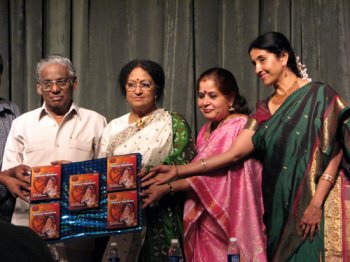 Two audio Cds for dance are part of the package. It is distributed by Kalakendra and available in many of the outlets in Chennai. It's the dream of every performing classical Indian artist to perform in Chennai during the December music and dance season. There could not have been a better place and time to release the DVD, says Bala Devi. It was a short and sweet function, the briefest DVD release function I have ever seen. The only irritant was a photographer, who actually pulled a chair in front of the first row, stood on it (unbelievable but true!) so he could be on level with the people on stage and took pictures, blocking the view of everybody! 'Height' of insensitivity. What was the necessity for this when he was already standing right in front?! It was good to see A Lakshman perform after a long time. Apart from being a fine guru, he is also a fine dancer and his performance that evening charmed the audience to the edge of their seats, all of them beaming in response to his every naughty glance, or come hither look, or pout! The audience came out of his performance smiling, sighing delightedly that he was better at these coy moves than even female dancers! An absolutely delightful performance. As soon as Lakshman finished, rose petals and green leaves were strewn in a border in front and rear of the stage, with candles burning in little transparent holders lined along these borders. The beautiful garlands were already hanging from the top of the stage, a rather novel decoration for a dance program. This was for Indance's second performance of 'Fallen Rain' in Chennai. Apart from Hari Krishnan and Srividya's items, Hari's student from Toronto, Nalin Bisnath presented a kurathi item. They covered the space well and it was nice to see the sheer energy of the duo right through the performance, just as in the first show at Spaces, which somehow had a better ambience suited to the theme. 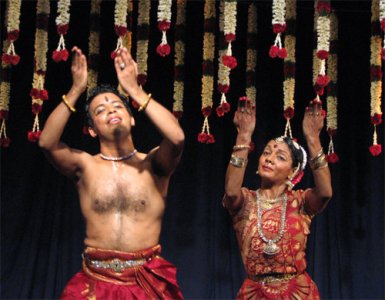 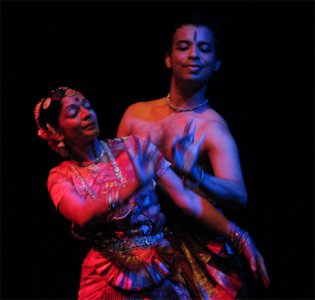 Hari Krishnan
and Srividya Natarajan
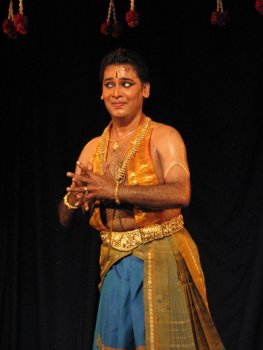 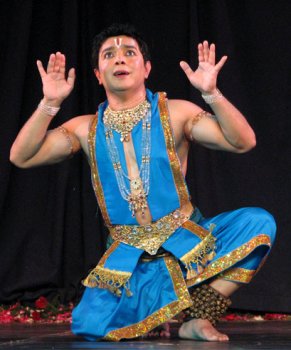 The final program of the evening was the solo production 'Sri Ranga Nayakam' by Zakir Hussain - a former student of Chitra Visweswaran - who is known for his research work in Sri Vaishnavism. (He knows so much about Vaishnavism that he would put a Vaishnavite to shame!) This production is the result of painstaking research and in-depth study of the myths and stories associated with the deity and the devotees of Sri Ranganathaswamy temple in Srirangam. He said he has read thousands of pages in this connection over the last couple of years. The central item had a string of tales woven together and included that of the dasi Vellaiammal, who sacrificed her life from the Vellai Gopuram (hence its name) to protect the temple jewels from the invader by luring him to the top of the tower and then pushing him to his death; the blind 90-year old washerman who could identify the original utsava moorthy (Namperumal) just by the taste of the water that was wrung from the clothes worn by the utsava moorthy. Zakir said he used the Srirangam version of the Andal story (where the lord pulls her over the threshold into the sanctum) instead of the Srivilliputhur version that says Andal merged with Ranganatha en route to Srirangam. It was helpful that Zakir first spoke about what he would be presenting as these tales are little known. Just the narration in beautiful, chaste Tamil brought the tears welling up in the eyes of the audience. I remembered Anita Ratnam had watched his premiere and told me that people were crying and I should not miss it! Though there was little nritta in the presentation, his evocative depiction of the various episodes was absorbing in its execution. The recurring sounds of the temple bells and the conch gave a very temple atmosphere. (I just visited Srirangam, my landlord told me after watching Zakir's first show!) The music was by Gomathi Nayagam, script by Revathy Sankkaran, and scholarly guidance by Krishnamachariar. The orchestra comprised of his student Lakshmi Venkatesh on nattuvangam, Ganesh on percussion, Nataraj on flute, Kaushik on vocal, and special effects by Saravanan. A little less jewellery and little less gilt on the costume would have been easier on the eye. 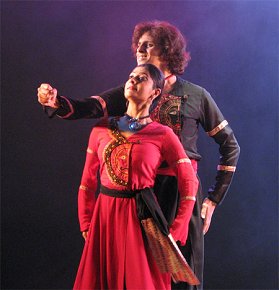 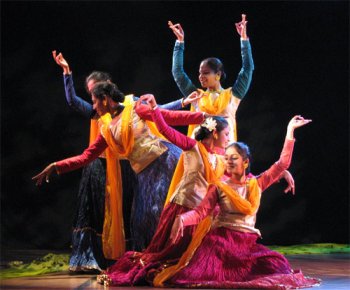 Nirupama, Rajendra and the Abhinava Dance Company are known for their beautiful colorful costumes, wonderful music and the energy and joy with which the whole group performs. One comes away with a happy feeling. And so it was on Jan 5 too at the Krishna Gana Sabha. Taking themes from different sources like mythology and puranas, they "give a different dimension to art." The story of Shakuntala and Dushyanta in shringara rasa was told through the eyes of a bee (played by Parshwanath Upadhaye) that narrates the story to a bunch of beautiful flowers. Music by Praveen D Rao combined Indian music, Afro percussion and symphony style. Varsha brought the magic of monsoon, the idealist aspect of it through images of the season - cool breeze, formation of clouds, the pit pat of the rain drops, dance of the peacock. The abhisarika nayika (Nirupama) sets out in the rain to meet her nayaka (Rajendra). The colorful raas item was next. Somashekar was the brave Abhimanyu and to depict his yuddha veera, special bols from the Natya Sastra were adapted and improvised. The beats of the Taiko drum and the bols gave the feel of a war on stage, reverberating through the auditorium since the volume was a tad high. In Mushti, Kathak movements are done to konakkol and the beautiful choreography of Guru Kumudhini Lakhia was joyous to behold. The duo wore striking red and black costumes for this item. The final item Kathakitathom was an excerpt from a longer version and was a huge hit. Two dancers jumped into the audience and prompted people to utter tha, thakita, kitathom and kathakitathom and the show ended with a standing ovation. Veteran dancer Sucheta Chapekar, a disciple of Thanjavur Kittappa Pillai and Acharya Parvati Kumar of Maharashtra, is well known for her presentations of Marathi compositions. In 1969, she had presented a full program of Marathi compositions by Serfoji. She performed compositions of the Maratha rulers of Thanjavur at Music Academy on the morning of Jan 6. She first heard "Tandava nritya kari gajanana" in a Yakshagana program in Andhra and the artistes themselves had not realized it was in Marathi. Sucheta recalled how she had performed that item in Music Academy 35 years ago, with Dr. V Raghavan presenting a scholarly intro before every item. The next item was "Pahile Krishna" from the manuscripts of King Shahji, set in keertana style composed by Kittappa Pillai, another 35 year old composition, which she thinks is his masterpiece. In Shahji's works, one does not find varnams, but in Serfoji's, one finds many varnams, she said. Sucheta Chapekar ended with the Jakkini daru, a forerunner of the tillana, by King Shahji that had choreography and music composition by Kittappa Pillai. "I have never changed even a little bit of this in all these years. Simplicity is sometimes very beautiful. Complexity is not always beautiful" she said to applause! The accompanying artistes were N Sivaprasad on vocal, KN Venkateswaran on mridangam, Arundati on nattuvangam and SR Balsubramaniam on violin. 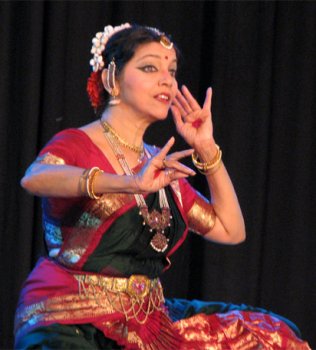 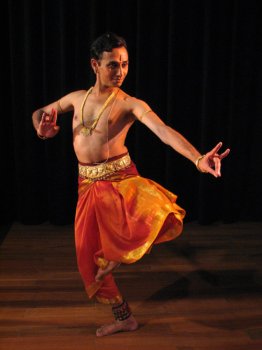 The next was a Bharatanatyam performance by Bangalore based P Praveen Kumar, who just received the Mohan Khokar Award for Excellence in Dance. And he kept up to his reputation. He presented Muthusamy Dikshitar's kriti "Sri Parthasarathy," a varnam "Ennai marandanalo" that centers around the plight of a lovelorn nayaka, pining for his beloved and going in search of her, while reminiscing of old memories of times spent with her. It is created, composed and choreographed by his Guru CV Chandrasekhar - good to see a man pining for a change! A devarnama "Baro Krishnanyya" by Purandaradasa was next and the concluding item was a beautiful thillana in raga Keeravani, composed and choreographed by CV Chandrasekhar. It was not the usual fast paced item that one expects of a thillana. Only one word describes it - delicate! Praveen maintained his sthayibhava throughout, commended Guru Kalanidhi Narayan. The distinguished orchestra had Guru CV Chandrasekhar on nattuvangam, Kalaiarasan on violin, Srivatsa on vocal and Srihari Rangaswamy on mridangam. Once the show was over, people had to go and meet Praveen outside (no more barging backstage to chit chat, there are volunteers guarding the door!) and it was nice to see many of them getting themselves photographed with Praveen with some even asking for his autograph. He was quite the star, justifiably so since the connoisseurs described his performance as one of the best of this season. In Music Academy, one has to go through security. Plus photography is not allowed inside. Had I known that, I'd have been spared the embarrassment of three volunteers breathing down my neck and admonishing me for taking a few pics of Sucheta Chapekar! There are watchful volunteers all over the hall. I was told I had to get permission of the committee members in order to take photos! The minute any cellphone camera or camera is whipped out anywhere, at least 2 volunteers make their way across people and wag their fingers - no photos! So, I asked Praveen to pose for me on stage after the show! He was happy on many counts. For him, performing at the Academy is a privilege since that stage has a special something. He said it was the first time a sabha had taken such good care of him and his troupe, train fare by a/c class for the whole group, a car at their disposal, a volunteer meeting them at the station and being with them through their stay, taking care of their food, and good hotel accommodation. Plus a decent fee that at least took care of the accompanying artistes! And the artistes are also given free passes for the evening programs. (The well attended morning programs of the dance festival are free). As I hurried the next morning back to Music Academy to watch the Dhananjayans present Nrityopaharam, I noticed the sign in the parking lot that read 'No parking for canteen visitors'!! (Must be the result of more people flocking to the canteen than to performances!) The 80 minute full length program was choreographed way back in 1978 by the Dhananjayans, and ran to almost full house. A Padavarnam on Ramayana in Kharaharapriya ragam composed by Tenmadom Narasimhachari (a contemporary of Thyagaraja) was set as a Nrityopaharam (an offering of narrative dance). Khara and Dooshana (supposed to be cousins of Ravana) are two demons killed by Rama. Khara haran, the one who killed Khara, that is Sri Rama; his priya is Sita or the raga liked by Rama - Khara hara priya. The chanting of Rama naama expels the six enemies of the human mind - kaama, krodha, moha, lobha, mada, maatsarya. The second half delineates Rama as the ultimate god dwelling in the creations as life itself. The episodes in the Ramayana are narrated in a nutshell, from Rama's birth to finally traveling in the pushpaka vimana and coronation. The episodes were presented alternately by the duo as solo pieces - an elaborate 'ekaahaarya lasyaangam.' The Dhananjayans were accompanied by N Sasidharan on vocal, S Sunil Kumar on flute, M Venkatakrishnan on nattuvangam, R Kalaiarasan on violin, KP Ramesh Babu on mridangam and R Lakshminarayanan on tambura. Sitting two rows in front of me was this season's newsmaker, "paper thaatha," an elderly gentleman who comes armed with his newspaper, and leaves after he's read the paper! Hopefully he enjoyed reading The Hindu Friday Review that morning! Next was a pleasing Bharatanatyam performance by Lakshmi Gopalaswamy. She presented Devi stuti to Goddess Kali, "Velanai vara solladi" composed by Dandayudhapani Pillai, a padam "Vadiga Gopaluni" and a thillana in Khamas composed by Lalgudi Jayaraman. The soulful singing of Murali Parthasarathy, the elegant recitation of jathis by Kiran Subramanyam who has composed the jathis for the morning's recital, flute by Jayaraman and violin by Natarajan was much appreciated by the audience. But the deep mystery voice (what we would call 'sexy' voice!) making the impeccable announcements caught one's attention. It was the guy "with the golden voice" - Govind! If only dancers would get someone to announce properly instead of getting people who get their pronunciations - of the items as well as names, especially foreign names! - all wrong. That evening, Bala Devi Chandrashekar, senior disciple of Padma Subrahmanyam, gave a Bharata Nrityam recital at Sivagami Pethachi Auditorium. Bala thoroughly enjoyed performing as one could see from her happy countenance. When it was announced that the Nritya Margam would be favorites of ML Vasanthakumari, a gentleman commented, "Then it must be nice!" The items presented were an invocatory mallari, sloka from Shyamaladandakam, a varnam in raag Khamas composed by Harikesanallur Muthiah Bhagavathar, "Baro Krishnayya" in ragamalika, "Dikku theriyadha kaatil" by Subramanya Bharati and concluded with a thillana by Swati Thirunal in ragam Dhanasree tuned by Lalgudi Jayaraman. The complex rhythmic patterns were specially created by Karaikudi Sivakumar. On nattuvangam was Pandanallur Pandian, Padma Shankar on vocal, Aarti Shankar on violin, Ramana on flute and Sudhaman on mridangam. I could hear some people singing or humming along through the program. The best was for the last. After the thillana, everyone in the audience waited for the mangalam. It did not happen. The orchestra started to wind up and could not believe that no one was leaving! The people were not even standing up to leave, they were all still sitting! The orchestra took the hint and only after the mangalam did the people file out!  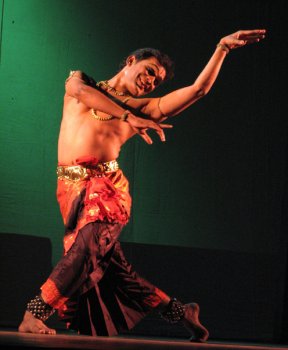 The evening of Jan 8 was spent swooning over love gained and love lost in 'Amour,' a program by Shanmuga Sundaram, disciple of KJ Sarasa, at Bharatiya Vidya Bhavan for Srinidhi Cultural Trust. When the dancer had gone to Switzerland, a friend gave him a calendar of Rodin's sculptures and suggested that he could do a program based on that. Everyone goes through emotions that affect them but they do not always express it, while an artist expresses through his sculpture, poetry, music or painting. Reading voraciously about Rodin, he realized that Rodin himself was inspired by Dante's Divine Comedy, a work about the love of Paolo and Francesca and full of deep philosophical thought, of which he read an available small Tamil translation a few years back. What was Dante's inspiration? He was 12 when he met 9 year old Beatrice, who unfortunately died when she was 24. In her memory, Dante wrote 'The New Life.' Camille Claudel, a student of Rodin, was in love with him, but they never married. All 3 were affected by love and provided the inspiration for 'Amour.' The dancer started with a mallari danced to nadaswaram and thavil. Rodin's sculpture 'The Thinker' signified the immortal love of Dante for Beatrice, a man who elevated his lost dead love to a goddess status. "Paayum oli nee enakku" went the lyrics of the song. In 'La Sommeil' Francesca recalls her love for Paolo in the Divine Comedy and yearns to be reunited with him. 'The Kiss' is about Paolo and Francesca who lived in love and died in love and found a parallel in the song "kaadhal kaadhal kaadhal poyin saadhal saadhal…" Camille Claudel was inspired by Shakuntala's story and the pangs of feelings she underwent came forth in the lyrics of Maraimalai Adigal and Kalidasa's Shakuntalam. After seeing a sculpture of the Thiruvalangadu Nataraja at an exhibition in Europe, Rodin was astounded and called it the perfect amalgamation of life and after life. He even wrote a poem in French on the 'Dance of Shiva' and with "kunitha puruvamum…" connected with Patanjali stotram, Shanmuga Sundaram concluded his interesting presentation. A slide show projected the sculpture in question with a brief well written narrative in Anusha Narendra Kumar's voice, followed by the dance item with the dancer freezing at the end of each item into the respective sculpture's pose. The music is composed by Shanmuga Sundaram with help from his guru KJ Sarasa. The beautiful soulful singing by Kuldeep Pai and Preethi Mahesh was supported by NK Kesavan on the mridangam, Shanmuga Sundaram and L Narendra Kumar on nattuvangam, plus nadaswaram and thavil artistes from Thanjavur. The text was originally written in Tamil by Shanmuga Sundaram and on his request, the ever helpful scholar TS Parthasarathy had translated it into English, and even typed it himself. He passed away a week later, recalls the dancer with emotion. A project that took five years to evolve, it was presented at the French Film Fest in Malaysia last May and very well received. 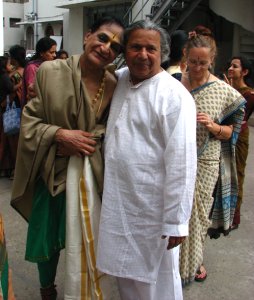  On the final day of the Music Academy dance festival on Jan 9, Prof. CV Chandrasekhar, clad in a bright green costume, gave a riveting performance. He presented a navarasa item followed by the Papanasam Sivan varnam "Swami naan undhan adimai" and the applause went on and on! Since navarasa has been done to death on stage, he has never performed it himself on stage in his long career and this was the first time. The item had sloka from the Shringara Thilakam, from Dr. Sivaramamurthy's book on Nataraja. Though his students perform this varnam, he himself has not. "This is the first time I've performed this varnam. Rukmini Devi sent me to Sivan to learn this item from him directly and I dedicate it to Shiva and Sivan," said CVC. Poets sing Pillai Thamizh imagining a god or goddess in the form of a child. Another first for the morning was Kumaragurupara's Pillai Thamizh on Muthukumaraswamy, showing the walk of the child, of its mother, sounds of different types of bells, how with his 6 faces Muruga gives one kiss to his mother and 5 kisses to his father and so on. CV Chandrasekhar thanked Gomathi Viswanathan for her suggestion to take up this item and Prof. Raghuraman for helping him with the meanings of the lyrics. The way he held his aramandi, going down on his knees and rising smoothly, bending to the floor level and then springing up effortlessly was admirable in a man his age when much younger dancers would have been panting and puffing. He maintained his balance doing sculpturesque poses, wisely choosing those that suited his age. The ever melodious Hariprasad on vocal, Manjari and Renjith Babu on nattuvangam, Sashidar on flute, Vedakrishnan on mridangam, Kalaiarasan on violin and Lakshminarayanan on tambura gave him wonderful music support. For CVC, the performance was precious because his alma mater Kalakshetra completed 75 years on Jan 6, he turned 75 last year and his own guru Sarada Hoffman was in the audience! So was Kunhiraman who had celebrated his 80th birthday a couple of weeks earlier in December, Vyjayanthimala Bali and a host of dance luminaries. The audience gave the maestro a 2 minute standing ovation. When CVC uncle had mentioned the earlier week that he was nervous about the performance, I did not know that he would be performing these items for the first time. That such a great teacher ("Don't call me 'guru,' not even 'Prof.' I want to be called just CV Chandrasekhar," he told me during an interview) is still nervous about a performance shows that he does not take his audience for granted. "It was heartening when people came up and told me 'It was not only your experience, you made us experience it.' It is not my energy alone. I draw my energy from the audience," he said about what keeps him going. Next followed a brilliant Mohiniattam recital by Jayaprabha Menon from Delhi. She wore a beautiful costume of cream with maroon border. Tha thom-Bhaja Govindam showcases the journey of a human life from cradle to the grave; there's no other salvation but Bhaja Govindam. It was set to music by Kavalam Narayana Panicker in ragamalika, chembada tala. In the padam, as Siddartha he is the beloved husband of Yashodara and as the Buddha, he is a person to be revered and worshipped - written and composed by Kavalam Narayana Panicker and set to sopanam music. The final item was about the mysticism of the number seven, the traveling of energy from the mooladhara chakra to the Sahasrara, composed by Kavalam Padmanabhan and choreographed by Bharati Sivaji. The accompanying artistes were Kottakkal Jayan (vocal), Thrissur Muralikrishna (veena), Irinjalakkuda Nandakumar (edakka) and Swati Das (maddalam). 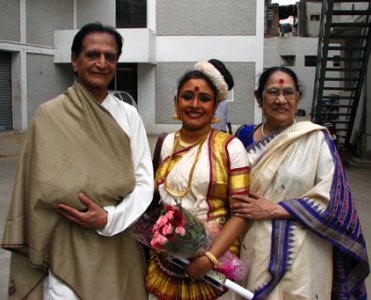 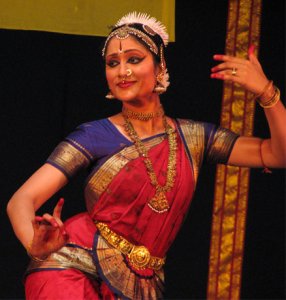 Janaki Rangarajan from Washington DC performed that evening at Mylapore Fine Arts. The items she presented were traditional invocation to Lord Gajasamharamurthy, pushpanjali composed by M Balamuralikrishna in ragam Arabi, a swarajati in ragam Husseini composed by Melattur Venkatrama Sastry, a lullaby to little Rama with verses from Kulasekhara Azhwar's Perumal Tirumozhi and Sant Tulsidas with music composed by Padma Subrahmanyam, a javali of Dharmapuri Subbarayar and a thillana in Behag, a composition of the Tanjore Quartet in praise of Brihannayaki. G Srikanth (vocal), S Vijayaraghavan (violin), Jayashree Ramanathan (nattuvangam) and SSR Krishnan (mridangam) provided accompaniment. Janaki is known for her enthralling performances and this evening was no exception. All items were choreographed by her. Originally trained by Padma Subrahmanyam, Janaki has now totally switched to Bharatanatyam but the occasional swaying hip and leg movements betray her Bharata Nrityam training (a hard habit to break!), and does add a spark to her presentation. 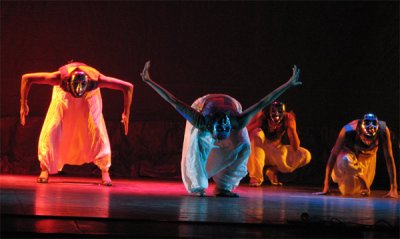 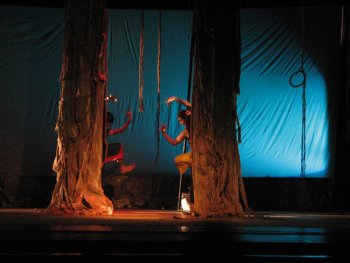 Nritarutya
and Chitraleka Dance Company
Bangalore based
Nritarutya and Chitraleka Dance Company from Birmingham presented a double
bill Maya-Ayam: Illusion of Time, at Narada Gana Sabha on Jan 11, to celebrate
innovative Indian dancing. The first presentation Swayam Shivam by Nritarutya
had costumes hand painted by Madhuri Upadhya. The choreography by Sathya
BG was set to music by Raghu Dixit and had kalari and Indian modern dance
movements. The dancers first wore masks, unmasking themselves as the item
progressed. Choreographed by Chitraleka Bolar, the Chitraleka Dance Company
presented Dasavatar using a blend of Bharatanatyam and contemporary movements,
set to the music of Praveen D Rao. Multimedia projection was used for some
of the avatars and with economic movements, each avatar was depicted admirably.
With super speed, the stage was transformed for the last item Ardhanariswara
with music by Raghu Dixit, costumes (what little we could see of it) by
Shonali and Himanshu. This piece had to be viewed from the center as 2
high vertical columns of sack cloth hung in the centre of the stage with
2 dancers behind each column doing movements anywhere from floor level
to high above - a bit of acrobatics behind the sack veil! Just legs stretching
out, a head poking out on the side, arms waving on either side of a column
- signifying the concept of Ardhanariswara as envisioned by Mayuri Upadhya.
It is difficult even for local dancers to get an audience and when out
of town artistes perform with next to no publicity, not even an insert
in the entertainment column of The Hindu, the result was disastrous, with
barely 20 in the audience. It was such a shame since so much work has gone
into the making of this collaborative presentation by such talented dancers
and choreographers, who incidentally had full house in Bangalore the earlier
evening. One happy happening was that Canada based Menaka Thakkar who is
in India on tour wanted to see this production, so she took a flight and
came to Chennai to attend it! She was very happy with the way her India
tour was going, all praise for her local presenters as well as auditorium
managers, in the places her troupe had performed. Artistes from outside
Chennai would do well to let a local organization present them than venture
themselves into unknown territory. Plus the Bolars also had to contend
with the sabha not allowing them more than 10 extra lights to the existing
paltry few (and foreign productions come with so much complex lighting!)
that seemed ancient to those having performed in technically advanced dance
spaces, plus they also had to contend with the equally ancient man who
controls backstage. And the group was not even aware that these very things
were the hot topics being debated in The Hindu and narthaki this season!I missed the canteen fare at the sabhas. I visited the Krishna Gana Sabha canteen just once when in the middle of an evening performance by a large troupe, I came out and met two senior dancers who were so 'depressed' with the quality of the production, they invited me to help them drown their sorrows in yummy kichidi and hot coffee! Seasons' pics 2010-2011 by Lalitha Venkat Lalitha Venkat is the content editor of narthaki.com |